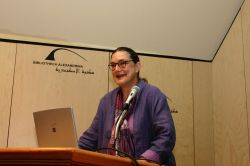Egypt’s presence in 17th Century Rome
Posted on
Alexandria, 2 October 2005—“Impressions of Egypt in 17th Century Rome” was the lecture given by Professor Ingrid Rowland, renowned art critic and art historian, at the Bibliotheca Alexandrina (BA) on Saturday, 1 October 2005.
During the lecture, Rowland, currently a professor at the University of Notre Dame School of Architecture, highlighted the fascination of Romans with Ancient Egypt, and its different manifestations in the streets of 17th Century Rome. The presence of ancient Egypt in Rome’s streets can still be seen today, and includes the Egyptian lions, which were transformed into fountains, obelisks and statues such as “Madama Lucrezia” which depicts the Egyptian goddess, Isis.
Rowland shed light on the German Jesuit Athanasius Kircher, one of those who played a major role in such manifestations. Part of Kircher’s fame is attributed to his claiming the ability to read ancient Egyptian hieroglyphs, among the 12 languages he declared to command. He believed that the Coptic language descended from ancient Egyptian, and hence held the answer to deciphering hieroglyphs. In this surmise, he was correct and was among the very first scholars to say so, although Coptic was not written the same way. Kircher’s works of art are evident in Rome and portray religious and scientific connotations.
Professor Rowland is one of the distinguished founding members of the Academia Bibliotheca Alexandrinae (ABA) at the BA. The ABA will create and maintain an international network of scientists, artists and scholars dedicated to promoting excellence in science and the arts.
 |
 |
| Professor Ingrid Rowland |
Professor Rowland and
Dr. Ismail Serageldin during the lecture |